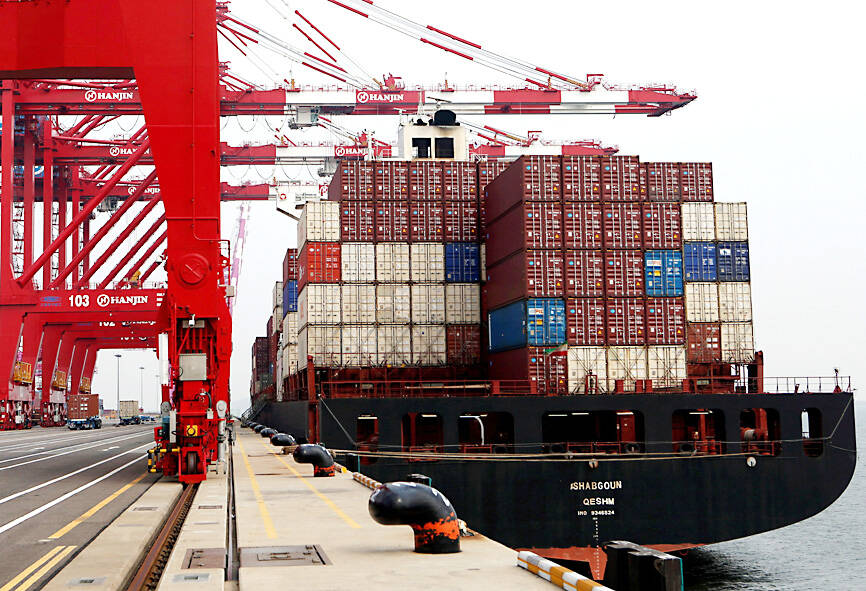South Korea’s exports returned to growth on the back of continuing demand for semiconductors, in a positive sign for policymakers seeking to shore up the trade-reliant economy against any potential headwinds from US president-elect Donald Trump’s tariff plans.
Exports adjusted for working-day differences rose 3.6 percent last month from a year earlier, rebounding from a dip in the prior month, data from the South Korean Ministry of Trade, Industry and Energy showed yesterday. Headline exports climbed 1.4 percent while imports decreased 2.4 percent, resulting in a trade surplus of US$5.6 billion.
Semiconductor exports increased 30.8 percent from a year earlier to US$12.5 billion, the trade ministry said. Still, it was the slowest growth since late last year.

Photo: REUTERS
South Korea is one of the world’s most export-reliant nations, and its vulnerability to protectionism has raised concerns among policymakers and business leaders in Seoul after Trump vowed to increase tariffs on trading partners.
While South Korea might be subjected to universal tariffs of just 10 percent, it could also sustain indirect damage from larger duties targeting some of its key trading partners. Trump has pledged 60 percent charges for China, South Korea’s biggest trading partner.
The Bank of Korea on Thursday slashed its benchmark interest rate in a surprise back-to-back move aimed at girding the economy for any potential headwinds stemming from Trump’s return to the White House next month.
The central bank has already voiced concerns about a softening in the export growth of technology products. South Korea is home to two of the world’s biggest memory chip manufacturers, and its businesses are widely embedded across global technology supply chains.
“Trump’s return to the White House suggests a tumultuous period lies ahead, with higher US tariffs and fresh US-China trade frictions impairing the smooth flow of goods and the functioning of supply chains,” Dave Chia, an associate economist at Moody’s Analytics, said in a note. “As a key US and China trading partner, South Korea could be caught in the middle.”
Demand from both China and the US slipped last month. Shipments to China edged down 0.6 percent from a year earlier while those to the US fell 5.1 percent, the trade ministry said.
Separately, South Korea has the capacity to purchase more US energy, which is competitive in cost with Middle East imports, Yonhap News yesterday cited Minister of Trade, Industry and Energy Ahn Duk-geun as saying.
Ahn told Yonhap that the country needs to expand US imports to reduce trade surplus with the US and plans to fold it into policy “constructively,” while private companies can take it into consideration as part of their business strategies.
The minister’s comments suggest South Korea will seek to encourage US energy imports through government-run firms and private refiners, Yonhap said. US gas and oil prices are “reasonable,” making it easier for South Korea to procure them, Ahn told Yonhap.
During Trump's election campaign, he vowed to narrow trade deficits with other countries through tariffs and increase US oil and gas production to establish what he called energy dominance.

Taiwan Semiconductor Manufacturing Co (TSMC, 台積電) last week recorded an increase in the number of shareholders to the highest in almost eight months, despite its share price falling 3.38 percent from the previous week, Taiwan Stock Exchange data released on Saturday showed. As of Friday, TSMC had 1.88 million shareholders, the most since the week of April 25 and an increase of 31,870 from the previous week, the data showed. The number of shareholders jumped despite a drop of NT$50 (US$1.59), or 3.38 percent, in TSMC’s share price from a week earlier to NT$1,430, as investors took profits from their earlier gains

In a high-security Shenzhen laboratory, Chinese scientists have built what Washington has spent years trying to prevent: a prototype of a machine capable of producing the cutting-edge semiconductor chips that power artificial intelligence (AI), smartphones and weapons central to Western military dominance, Reuters has learned. Completed early this year and undergoing testing, the prototype fills nearly an entire factory floor. It was built by a team of former engineers from Dutch semiconductor giant ASML who reverse-engineered the company’s extreme ultraviolet lithography (EUV) machines, according to two people with knowledge of the project. EUV machines sit at the heart of a technological Cold

TAIWAN VALUE CHAIN: Foxtron is to fully own Luxgen following the transaction and it plans to launch a new electric model, the Foxtron Bria, in Taiwan next year Yulon Motor Co (裕隆汽車) yesterday said that its board of directors approved the disposal of its electric vehicle (EV) unit, Luxgen Motor Co (納智捷汽車), to Foxtron Vehicle Technologies Co (鴻華先進) for NT$787.6 million (US$24.98 million). Foxtron, a half-half joint venture between Yulon affiliate Hua-Chuang Automobile Information Technical Center Co (華創車電) and Hon Hai Precision Industry Co (鴻海精密), expects to wrap up the deal in the first quarter of next year. Foxtron would fully own Luxgen following the transaction, including five car distributing companies, outlets and all employees. The deal is subject to the approval of the Fair Trade Commission, Foxtron said. “Foxtron will be

INFLATION CONSIDERATION: The BOJ governor said that it would ‘keep making appropriate decisions’ and would adjust depending on the economy and prices The Bank of Japan (BOJ) yesterday raised its benchmark interest rate to the highest in 30 years and said more increases are in the pipeline if conditions allow, in a sign of growing conviction that it can attain the stable inflation target it has pursued for more than a decade. Bank of Japan Governor Kazuo Ueda’s policy board increased the rate by 0.2 percentage points to 0.75 percent, in a unanimous decision, the bank said in a statement. The central bank cited the rising likelihood of its economic outlook being realized. The rate change was expected by all 50 economists surveyed by Bloomberg. The